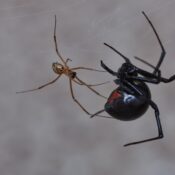Although rats have been acquitted of charges they spread the Black Death, a plague that wiped out half of Europe’s population in the 12th century, their reputation hasn’t improved, not a whisker. Granted, their image suffers from distasteful habits like spoiling 22 percent of the world’s food supply each year and swimming up sewer pipes to emerge in toilets. While it was human lice, not rats’ fleas, that dispersed the Black Death, rats spread other diseases like hantavirus and salmonella. In addition, the ticks they harbor carry illnesses such as Lyme disease and Babesiosis.
Known variously as the brown rat, Norway rat, sewer rat, and probably some names unfit to print, rats live and breed the world over, except for Antarctica. Apparently, the Canadian province of Alberta, where they deploy commandos if just one rat is found, is considered rat-free as well.
Adaptable to a fault, rats are tough to control. But with the right information and minimal effort, rats in residential settings can usually be eliminated, so long as homes remain rat-proofed.
If you’ve never seen a rat, they can be identified by their greyish-brown fur, pointy nose, 9- to 11-inch cylindrical body, and a 6- to 9-inch scaly, hairless tail. Despite urban legends about cat-size rats, the largest brown rat on record was 20 inches long (including the tail), and weighed nearly two pounds.
One reason rats get the jump on us is that they’re good with numbers. Saying rats multiply fast is like saying the ocean is kind of wet. A female rat is sexually mature at three months, and bears 6-12 pups per litter, a performance she repeats 4-7 times per year. And females can get pregnant within hours of giving birth. Whether or not they want to is anyone’s guess.
If you start with a pair of rats (I’m not saying you would) and let them breed to their potential, in a year you could have 12,000 to 15,000 of their progeny milling about, wondering what’s for dinner. A breeding couple (of rats, I mean) could conceivably produce nearly 500,000,000 descendants in just three years. This shocking figure is hypothetical, as rats seldom make it past their second birthday, and not all rodent offspring live to maturity.
Rats will eat anything from cadavers to caviar, and feces to fettuccini. With noses 700 times more sensitive than a dog’s sniffer, they’re experts at finding food. Long, flexible claws let them climb sheer walls better than Spiderman, and adult rats can squeeze through openings the size of a quarter. If there aren’t any holes, they’ll try to make some, gnawing through wood, plaster, and even concrete to get a meal.
Whether you have a rat infestation or wish to prevent one, the rat-control recipe is the same. First comes sanitation, which applies to the cleanest and messiest homes alike. Rats love our pets, because to them, pet poop and pet food are equally good. If you have either outside your home, you have a rat feeder. Speaking of which, rats flock to bird feeders with spilled seed underneath. Frequent cleaning around bird feeders helps reduce bird diseases while depriving rats of food – a win-win for bird lovers. Also, tidying the yard makes a site less hospitable to rats.
Then comes exclusion. Gaps more than ¼-inch wide, such as where utilities pass through exterior walls, should be plugged with steel wool, flashing, or heavy-gauge mesh before caulking. Rubber door sweeps let rats in, but metal sweeps stop them. Cover floor drains, sump hoses, and dryer vents with galvanized steel mesh. Galvanized steel bins with tight-fitting lids should be used to store bird seed and pet food. Garbage cans should be of the same construction.
Indoor trapping is next (don’t use poison indoors). The Centers for Disease Control cautions against glue traps, but old-fashioned snap-traps are effective. For best results, use a large number of traps at first, as one or a few traps educate the other rats to avoid traps. The key is to bait the traps, unset, for several days until rats feel safe taking the bait. Then, set the traps and place them along walls and runways.
Follow the same strategy outdoors, but create barriers to keep pets away from traps. Rodenticides can be effective when used as directed. However, more than 10,000 American children are poisoned from ingesting rat bait each year, along with an estimated 232,000 pets. Rodenticides are especially toxic to dogs. Because most rat poisons take several days to work, exposed rats, weak from toxins, are easier for birds of prey and other wildlife to catch, resulting in illness and death.
Paradoxically, domestic strains of Norway rats make wonderful pets. They’re gentle, affectionate, and chortle with joy when you tickle them. They may not have the cunning genius of the Rats of NIMH (thankfully), but they’re fast learners. Rats can be taught to play hide-and-seek (with peers or humans), which seems to delight them, and in 2021, a French artist trained rats to take adorable selfies. With a legacy like theirs, and a name that serves as a mild expletive, rats face an uphill battle to redeem their reputation. But you never know. Rats are already taking selfies, and a social media presence could be next. Maybe a cooking channel – ratatouille, anyone?
Become a Saturday Evening Post member and enjoy unlimited access. Subscribe now




Comments
Good information on rats, even if too much. Let the people of Norway enjoy them as pets. I’ll pass if ever offered.
Of course there are several poisons used to rid rats, which some work well and others don’t. In rural areas, snakes help rid the rats but then depending on whether they’re poisonous or not you have the snakes to deal with.
Another way many who own a .22 rifle and are a decent marksman is to purchase rat shot cartridges. I have killed many rats in and around out-buildings, barns, garages, sheds, and even homes doing this. It makes my wife a little nervous if it’s in the house even though she knows I never miss. In fact, I find a bit of a sport in killing rats using this method in an amusing sort of way.